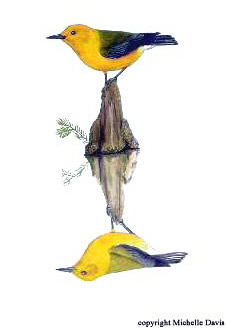For migrating passerines, the timing and direction of departure from stopover
areas are most likely guided by a number of factors, including weather conditions
(Able 1973), body condition (Sandberg and Moore 1996), and experience (Woodrey and Moore 1997).
Migration can be a hazardous journey as birds may be unable to predict weather
conditions and resource availability along their route, and problems encountered
can result in lowered reproductive success and/or death for the individual.
Ecological barriers, such as deserts and water bodies, present additional complications
for migrating birds as these areas are generally resource poor and provide no reliable
place in which to land in the event of bad weather or other difficult circumstance.
As a student of the migratory bird group at the University of Southern Mississippi,
I am interested in answering questions about the migratory behavior of birds in coastal areas.
Currently, I am working on a thesis research project that hopes to examine how age, energetic
condition and/or weather influence migratory departures of Swainson’s thrushes (Catharus ustulatus)
from a stopover site on the Northern Gulf of Mexico coast. This site (Fort Morgan, Alabama)
encompasses Bon Secour National Wildlife Refuge where, for the past 15 years, Dr. Frank Moore
and his graduate students have studied autumn bird migration. My project proposes to
investigate when and in what direction birds leave the site. By using automated radio tracking,
we can track numerous birds and acquire a wealth of data about their movements.
I am excited to use automated radio tracking to help answer some questions about bird migration.
Initially developed in 1963 by scientists and engineers at
Cedar Creek Natural History Area
in MN (Cochran et al 1965), this technology allows researchers to place ordinary radio
transmitters on study subjects and follow their movements simultaneously.
By combining the data from numerous towers, one is able to triangulate a position for the
study animal. Thus by using this information, we may better understand aspects of migratory
departures that are potentially hazardous but decidedly important decisions in a migrant’s life.
References
Able, K. 1973. The role of weather variables and flight direction in determining the magnitude of nocturnal bird migration. Ecology 54:1031-1041.
Cochran, W.W., D.W. Warner, J.R.Tester, and V.B. Kuechle. 1965. Automatic radio-tracking system for monitoring animal movements. BioScience 2:98-100.
Sandberg, R. and F. R. Moore. 1996. Migratory orientation of red-eyed vireos, Vireo olivaceus, in relation to energetic condition and ecological context. Behavioral Ecology & Sociobiology 31:1-10.
Woodrey, M. S. and F. R. Moore. 1997. Age-related differences in the stopover of fall landbird migrants on the coast of Alabama. The Auk 114:695-707.
